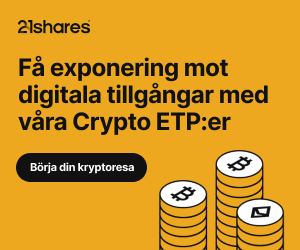Nyheter
Vad är en utdelnings-ETF?
Publicerad
12 månader sedanden

Utdelnings-ETF är ett populärt verktyg för inkomstinvesteringar. En utdelnings-ETF ger investerare ett bekvämt sätt att få tillgång till en diversifierad portfölj av utdelningsbetalande aktier till låg kostnad, som erbjuder potentiella intäkter och fördelarna med bred marknadsexponering.
En utdelnings-ETF är en börshandlad fond som fokuserar på att investera i en portfölj av utdelningsbetalande aktier. Dessa ETFer ger investerare exponering mot företag som regelbundet delar ut en del av sin vinst som utdelning. Utdelnings-ETFer riktar sig till investerare som söker inkomst genom regelbundna utdelningar, tillsammans med potentiell kapitaltillväxt.
Hur fungerar utdelnings-ETFer?
Utdelnings-ETFer investerar i en portfölj av aktier som har en historia av att betala regelbunden utdelning. Dessa ETFer syftar till att ge investerare en inkomstkälla genom att dela ut utdelningar från de underliggande aktierna.
Så här fungerar utdelnings-ETFer vanligtvis
- Passiv eller aktiv förvaltning: Utdelnings-ETFer kan förvaltas antingen passivt eller aktivt. Passivt förvaltade fonder syftar till att replikera resultatet för ett specifikt utdelningsfokuserat index, såsom S&P U.S. Dividend Growers Index eller Dow Jones U.S. Dividend 100 Index, medan aktivt förvaltade fonder involverar portföljförvaltare som aktivt väljer och hanterar portföljen av utdelningsbetalande lager.
- Aktieurvalskriterier: Aktivt förvaltade utdelnings-ETFer kan försöka överträffa ett utdelningsaktieindex genom att följa specifika urvalskriterier, såsom faktorbaserade strategier. Detta kan inkludera att fokusera på företag med en historia av att betala konsekvent utdelning, de som har en meritlista med att öka utdelningen över tid, eller företag med hög utdelningsavkastning.
- Direktavkastning: Utdelningsavkastningen för en ETF är ett nyckelmått. Den representerar den årliga utdelningsinkomsten i procent av ETFens aktuella aktiekurs. Utdelnings-ETFer väljs ofta av inkomstorienterade investerare som söker en pålitlig inkomstström.
- Diversifiering: Utdelnings ETFeer strävar efter att ge investerare en diversifierad exponering mot utdelningsbetalande aktier inom olika sektorer och branscher. Denna diversifiering hjälper till att sprida risker och kan bidra till en mer stabil inkomstström.
- Inkomstfördelning: Utdelnings-ETFer delar ut intäkter till investerare som periodiska utdelningar. Frekvensen av utdelningar kan variera, med vissa ETFer som betalar utdelning kvartalsvis, halvårsvis eller årligen. Det finns även en som har veckovis utdelning.
- Kostnadskvoter: Liksom andra ETFer har utdelnings-ETFer kostnadskvoter, som täcker fondens driftskostnader. Investerare bör överväga dessa avgifter när de utvärderar den totala kostnaden för att äga den börshandlade fonden.
Utdelningstillväxt kontra högavkastande ETFer
ETFer för utdelningstillväxt och ETFer med hög utdelning är två distinkta typer av börshandlade fonder som fokuserar på olika aspekter av utdelningsinvesteringar. De primära skillnaderna ligger i deras investeringsmål relaterade till utdelningsegenskaper. Valet mellan de två beror på en investerares mål, risktolerans och tidshorisont. Vissa investerare kan till och med välja att kombinera båda typerna av ETFer för att uppnå en balanserad inkomststrategi.
ETFer för utdelningstillväxt
Utdelningstillväxts ETFer prioriterar företag med historia av att konsekvent öka sina utdelningar över tid. Dessa fonder är designade för investerare som inte bara söker nuvarande inkomst utan också potential för framtida inkomsttillväxt.
Här är en uppdelning av hur utdelningstillväxts-ETFer fungerar
- Hur de investerar: Dessa fonder investerar vanligtvis i företag med starka finansiella fundament, stabila vinster och ett åtagande att återföra värde till aktieägarna genom regelbundna utdelningshöjningar.
- Direktavkastning: Även om utdelningsavkastningen för ETFer för utdelningstillväxt kanske inte är lika hög som vissa andra inkomstfokuserade strategier, ligger tonvikten på hållbar och växande utdelning snarare än omedelbar hög inkomst.
- Investerarprofil: utdelningstillväxts-ETFer är ofta lämpliga för långsiktiga investerare som prioriterar en kombination av inkomst och potentiell kapitaltillväxt. Fokus ligger på att bygga en portfölj av företag med en historia av ansvarsfull kapitalallokering.
Högavkastande ETFer
En ETF med hög utdelning är en börshandlad fond som fokuserar på att investera i en portfölj av aktier eller andra inkomstgenererande värdepapper med en utdelningsavkastning som är relativt över genomsnittet. Dessa ETFer syftar till att ge investerare en stadig inkomstström, vilket gör dem populära bland inkomstsökande investerare.
Här är en uppdelning av hur högavkastande-ETFer fungerar
- Hur de investerar: Högavkastande ETFer kan inkludera företag med högre direktavkastning, ofta från sektorer som allmännyttiga företag, fastigheter eller telekommunikation. Fokus ligger på att generera omedelbara intäkter, och historia av utdelningstillväxt har mindre prioritet.
- Direktavkastning: Högavkastande ETFer har vanligtvis en högre direktavkastning jämfört med ETFer för utdelningstillväxt. De betonar att maximera inkomstflödet.
- Investerarprofil: High Yield ETFer är ofta lämpliga för inkomstsökande investerare som prioriterar stadiga inkomster och som kanske är villiga att acceptera högre risk i utbyte mot högre avkastning.
Tidsöverväganden
Investerare kan också överväga tidpunkten för utdelningar när de bestämmer hur de ska ta emot dem. Vissa investerare föredrar regelbundet, periodiskt kassaflöde, medan andra kan välja mindre frekventa men större kontantutdelningar. Investerare kan också överväga ETFens utdelningsdatum för att planera tidpunkten för utdelningen.
Liksom enskilda aktier sätter ETFer ett ex-utdelningsdatum, ett avstämningsdatum och ett betalningsdatum. Dessa datum avgör vem som får utdelningen och när utdelningen betalas ut. Tidpunkten för dessa utdelningar är på ett annat schema än ETFens aktieinnehav och varierar beroende på ETF. Investerare kan hitta en ETF:s utdelningsdatum i fondens prospekt.
Fördelar med utdelnings-ETFer
Utdelnings-ETFer erbjuder investerare flera fördelar, inklusive inkomstgenerering, diversifiering och mer stabil avkastning jämfört med tillväxtorienterade investeringar.
Här är de viktigaste potentiella fördelarna med utdelnings-ETFer
- Inkomstgenerering: Utdelnings-ETFer ger investerare en konsekvent inkomstström genom regelbundna utdelningar från de underliggande innehaven. Detta kan vara attraktivt för inkomstfokuserade investerare, inklusive pensionärer, som söker pålitligt kassaflöde.
- Diversifiering: Utdelnings-ETFer har vanligtvis en diversifierad portfölj av utdelningsaktier eller inkomstgenererande värdepapper. Denna diversifiering hjälper till att sprida risker och kan förbättra den övergripande portföljstabiliteten.
- Potential för utdelningstillväxt: Vissa utdelnings-ETFer fokuserar på företag med en historia av ökande utdelningar över tid. Denna betoning på potential för utdelningstillväxt kan tilltala investerare som letar efter en kombination av inkomst och potentiell kapitaltillväxt.
- Passiv investering: Många utdelnings-ETFer hanteras passivt och spårar specifika utdelningsfokuserade index. Detta passiva tillvägagångssätt kan ge investerare en bred exponering mot utdelningsbetalande aktier utan behov av aktivt aktieurval.
- Lägre volatilitet: Aktier med utdelning, som ofta utgör innehav av utdelnings-ETFer, är ibland förknippade med lägre volatilitet jämfört med aktier som inte ger utdelning. Denna egenskap kan ge stabilitet under marknadsnedgångar.
Nackdelar med utdelnings-ETFer
Även om utdelnings-ETFer erbjuder många fördelar, bör investerare också vara medvetna om deras potentiella nackdelar, såsom räntekänslighet och sektorkoncentration.
Här är de viktigaste potentiella nackdelarna med utdelnings-ETFer
- Avkastningsbegränsningar: Utdelningsfonder kanske inte ger den högsta avkastningen jämfört med enskilda högavkastande värdepapper. Investerare som söker maximal nuvarande inkomst kan finna andra inkomstfokuserade investeringar mer lämpliga.
- Räntekänslighet: Aktier som ger utdelning kan vara känsliga för ränterörelser. När räntorna stiger kan utdelningsavkastningen bli mindre attraktiv, vilket potentiellt påverkar resultatet för utdelnings-ETFer.
- Sektorkoncentration: Vissa utdelnings-ETFer kan ha sektorkoncentrationer och deras resultat kan påverkas av dessa sektorers prestanda. Övertilltro till specifika sektorer kan utsätta investerare för sektorspecifika risker.
- Risk för utdelningssänkningar: Konjunkturnedgångar eller finansiella utmaningar kan leda till att företag skär ner eller tar bort utdelningar. Utdelningsfonder är inte immuna mot denna risk, och investerare kan uppleva minskade inkomster under utmanande marknadsförhållanden.
Är utdelnings-ETFer en bra investering?
Utdelnings-ETFer kan vara en bra investering för vissa investerare, särskilt de som söker inkomst och diversifiering, såsom pensionerade investerare. Att investera i utdelningsfonder kan minska risken genom att fokusera på finansiellt sunda företag, eftersom företag som konsekvent betalar utdelning generellt uppfattas som finansiellt stabila och väletablerade.
Sammanfattningsvis erbjuder utdelnings-ETFer inkomstpotential och diversifieringsfördelar men kommer med begränsningar och risker. Investerare bör noggrant utvärdera sina investeringsmål, tidshorisont och risktolerans för att avgöra om dessa börshandlade fonder överensstämmer med deras övergripande finansiella strategi. Dessutom är det viktigt att ta hänsyn till faktorer som skattekonsekvenser och marknadsförhållanden för att fatta välgrundade investeringsbeslut.
Du kanske gillar
-
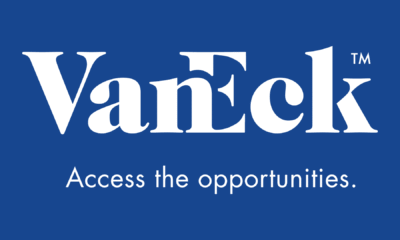

VanEcks utdelnings-ETF fördubblas, når två miljarder euro på sex månader
-


UDVD ETF investerar i amerikanska utdelningsaktier
-


GGRB ETF investerar i utdelningsaktier med hög kvalité
-


WGRU ETF köper kvalitativa utdelningsaktier
-


XGSD ETF köper aktierna med högst utdelning i STOXX Global 1800 Index
-


VGWE ETF spårar högutdelande aktier från hela världen
Nyheter
From digital asset to safe haven: Why is Bitcoin acting like gold?
Publicerad
14 timmar sedanden
28 april, 2025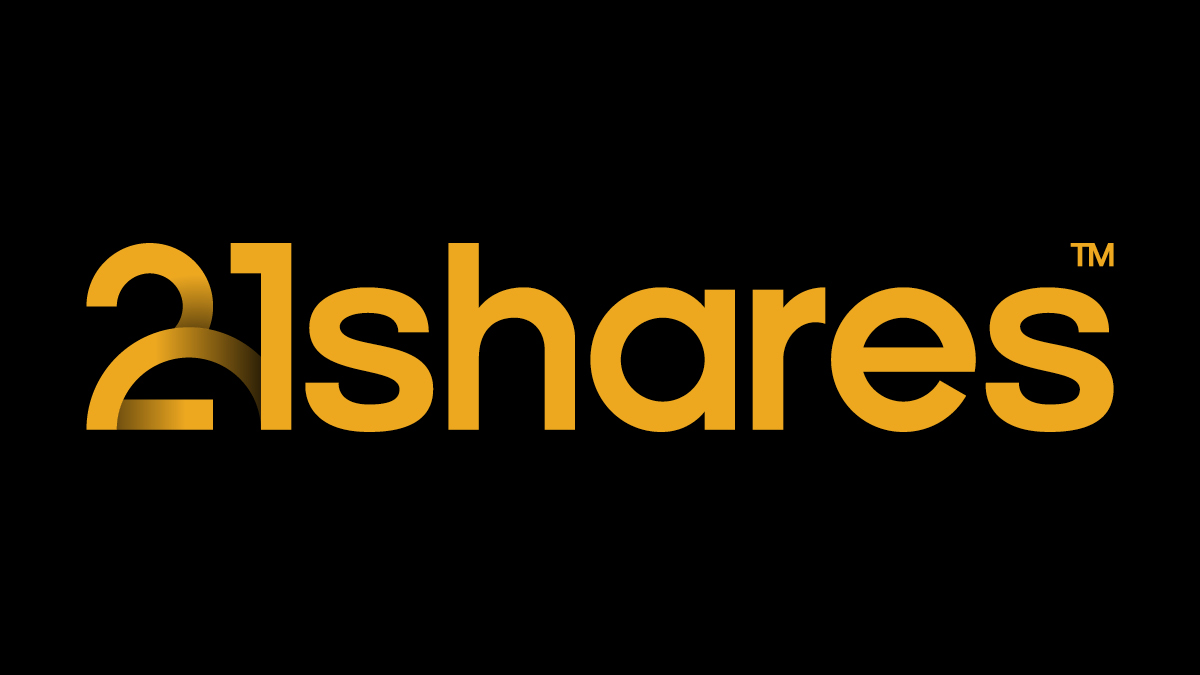
Bitcoin’s price has taken a different path from U.S. stocks over the past weeks. While major indexes such as the S&P 500 and Nasdaq have experienced declines, Bitcoin has risen to its highest levels in recent months, positioning itself as a safe haven, similar to gold. Understand how Bitcoin and gold have been synced for some time and what the correlation might look like in the future.
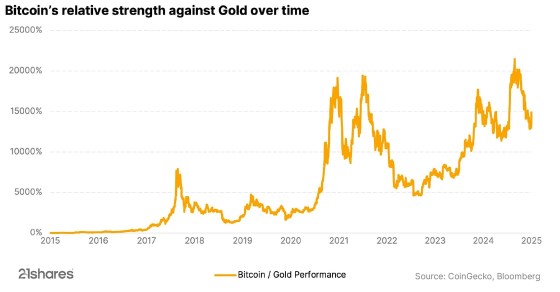

Ethereum’s big reboot: Why investors should be excited
Ethereum is making headlines due to a potential change in its core software, the Ethereum Virtual Machine (EVM), that operates across thousands of computers, enabling Ethereum to execute smart contracts and securely track transactions. However, Ethereum’s co-founder, Vitalik Buterin, has suggested replacing the EVM with a new system called RISC-V. Discover why the change is necessary and its potential impact on investors.
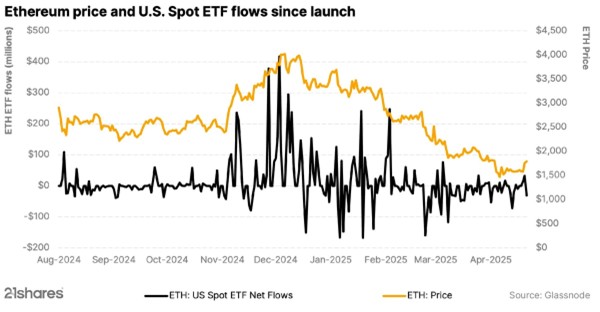


Thousands of altcoins, but no altcoin season: What comes next?
Over the past year, the crypto market has entered a new era. Bitcoin hit new all-time highs, outperforming other cryptocurrencies and decoupling from the stock market. Unlike previous cycles, the expected “altcoin season” did not occur, with Bitcoin remaining strong and money not flowing into other cryptocurrencies or altcoins. So, the big question is: Has altcoin season run its course?
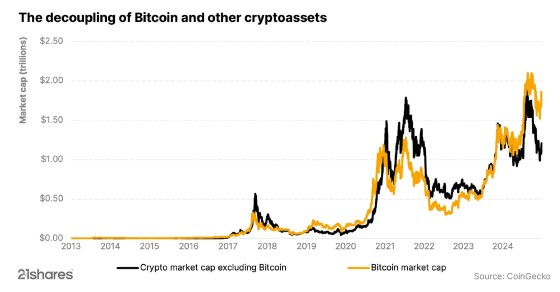

Research Newsletter
Each week the 21Shares Research team will publish our data-driven insights into the crypto asset world through this newsletter. Please direct any comments, questions, and words of feedback to research@21shares.com
Disclaimer
The information provided does not constitute a prospectus or other offering material and does not contain or constitute an offer to sell or a solicitation of any offer to buy securities in any jurisdiction. Some of the information published herein may contain forward-looking statements. Readers are cautioned that any such forward-looking statements are not guarantees of future performance and involve risks and uncertainties and that actual results may differ materially from those in the forward-looking statements as a result of various factors. The information contained herein may not be considered as economic, legal, tax or other advice and users are cautioned to base investment decisions or other decisions solely on the content hereof.
Nyheter
WELC ETF ger exponering mot företag inom sällanköpsvaror
Publicerad
15 timmar sedanden
28 april, 2025
Amundi S&P Global Consumer Discretionary ESG UCITS ETF DR EUR (D) (WELC ETF) med ISIN IE00061J0RC6, strävar efter att spåra S&P Developed Ex-Korea LargeMidCap Sustainability Enhanced Consumer Discretionary index. Det S&P-utvecklade ex-Korea LargeMidCap Sustainability Enhanced Consumer Discretionary-indexet spårar stora och medelstora företag från den diskretionära konsumentsektorn. ESG-kriterier (miljö, social och bolagsstyrning) beaktas vid valet av värdepapper.
Den börshandlade fondens TER (total cost ratio) uppgår till 0,18% p.a.. Amundi S&P Global Consumer Discretionary ESG UCITS ETF DR EUR (D) är den billigaste ETF som följer S&P Developed Ex-Korea LargeMidCap Sustainability Enhanced Consumer Discretionary index. ETFen replikerar det underliggande indexets prestanda genom fullständig replikering (köper alla indexbeståndsdelar). Utdelningarna i ETFen delas ut till investerarna (Årligen).
Amundi S&P Global Consumer Discretionary ESG UCITS ETF DR EUR (D) är en mycket liten ETF med 5 miljoner euro förvaltade tillgångar. Denna ETF lanserades den 20 september 2022 och har sin hemvist i Irland.
Investeringsmål
AMUNDI S&P GLOBAL CONSUMER DISCRETIONARY ESG UCITS ETF DR – EUR (D) försöker replikera, så nära som möjligt, resultatet för S&P Developed Ex-Korea LargeMidCap Sustainability Enhanced Consumer Discretionary Index (Netto Total Return Index). Denna ETF har exponering mot stora och medelstora företag i utvecklade länder. Den innehåller uteslutningskriterier för tobak, kontroversiella vapen, civila och militära handeldvapen, termiskt kol, olja och gas (inkl. Arctic Oil & Gas), oljesand, skiffergas. Den är också utformad för att välja ut och omvikta företag för att tillsammans förbättra hållbarhet och ESG-profiler, uppfylla miljömål och minska koldioxidavtrycket.
Handla WELC ETF
Amundi S&P Global Consumer Discretionary ESG UCITS ETF DR EUR (D) (WELC ETF) är en europeisk börshandlad fond. Denna fond handlas på flera olika börser, till exempel Deutsche Boerse Xetra.
Det betyder att det går att handla andelar i denna ETF genom de flesta svenska banker och Internetmäklare, till exempel Nordnet, SAVR, DEGIRO och Avanza.
Börsnoteringar
Största innehav
Denna fond använder fysisk replikering för att spåra indexets prestanda.
| Namn | Valuta | Vikt % | Sektor |
| AMAZON.COM INC | USD | 18.89 % | Sällanköpsvaror |
| TESLA INC | USD | 13.29 % | Sällanköpsvaror |
| HOME DEPOT INC | USD | 5.75 % | Sällanköpsvaror |
| LVMH MOET HENNESSY LOUIS VUI | EUR | 5.44 % | Sällanköpsvaror |
| TOYOTA MOTOR CORP | JPY | 4.58 % | Sällanköpsvaror |
| MCDONALD S CORP COM NPV | USD | 2.63 % | Sällanköpsvaror |
| LOWE S COS INC COM US 0.50 | USD | 2.38 % | Sällanköpsvaror |
| SONY GROUP CORP (JT) | JPY | 2.25 % | Sällanköpsvaror |
| BOOKING HOLDINGS INC | USD | 2.02 % | Sällanköpsvaror |
| TJX COMPANIES INC | USD | 1.89 % | Sällanköpsvaror |
Innehav kan komma att förändras
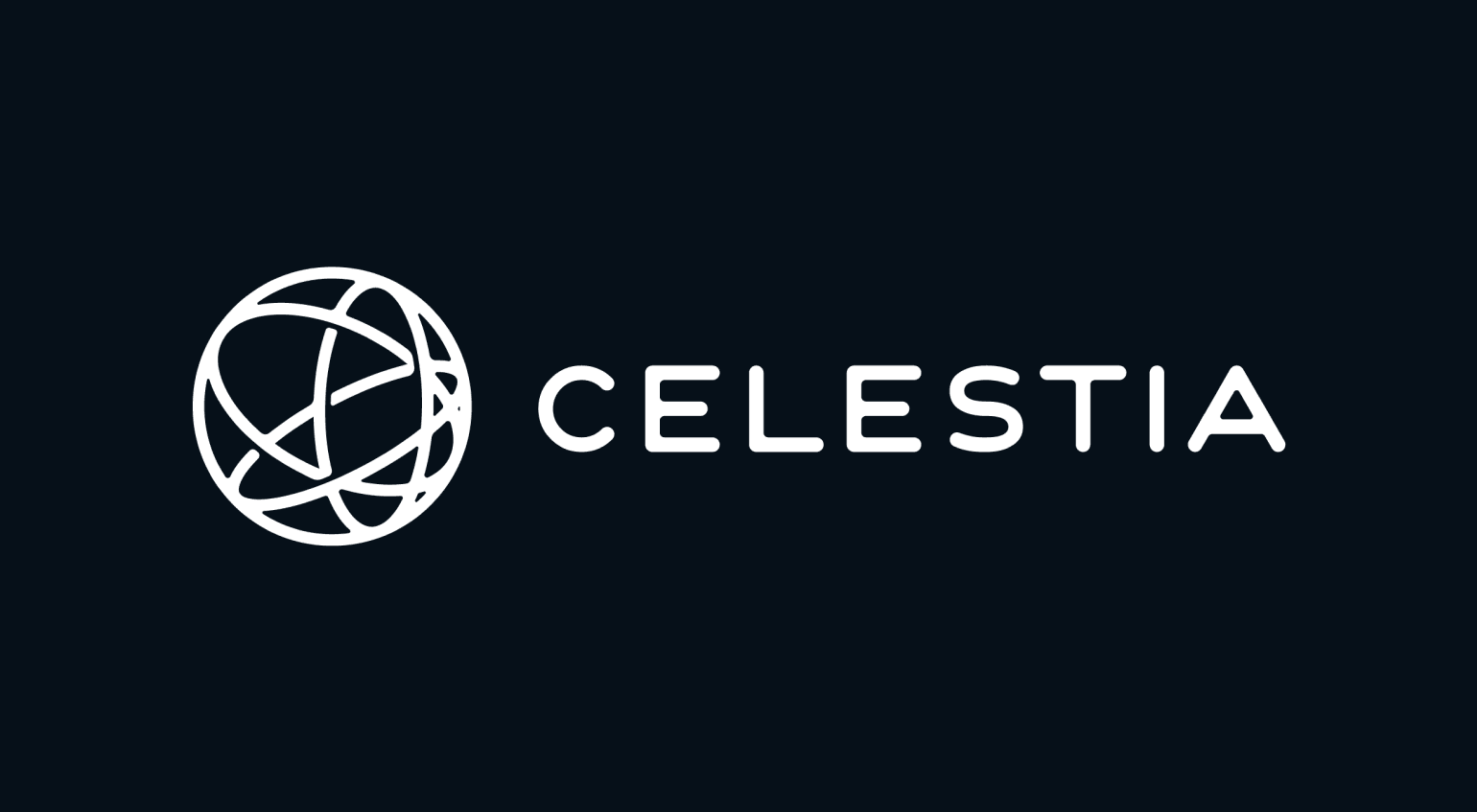
To understand Celestia’s value and its role in the ecosystem, it’s helpful to first understand how traditional blockchain systems are structured.
Most blockchains, like Ethereum or Bitcoin, are monolithic which means they perform all major functions (consensus, data availability, and execution) on a single layer. This design ensures security but according to new modular networks, limits scalability and flexibility.
The modular blockchain thesis, which Celestia is leading, proposes separation of layers and respective responsibilities in the network. Instead of having one network and its validators perform all of its functions, it may be better to have specialized layers:
• Consensus Layer: Ensures that all nodes agree on the order of transactions.
• Data Availability Layer: Ensures transaction data is accessible to all participants.
• Execution Layer: Processes the actual logic and computation of smart contracts.
By unbundling these components, developers can build more efficient, flexible systems that scale far beyond what monolithic blockchains can support. Not all applications need similar levels of security and not all applications need to scale up to millions of transactions. Additionally, one application might be scaling beyond the capabilities of its host network, severely effecting the available data throughput of other applications. This limits developers to the monolithic technology stack provided by a virtual machine such as Ethereum’ EVM.
The Issue of Data Availability
One of the most misunderstood yet crucial components of any blockchain is data availability. In simple terms, it ensures that the data behind each block is fully accessible and verifiable by all participants in the network. Another way to describe it is as the confidence a user can have that the data required to verify a block is really available to all network participants. Data availability is therefore important to all stakeholders of the blockchain ecosystem.
If a block producer withholds data, then nodes cannot verify the block, which leads to potential censorship or fraud.
Traditionally, a blockchain network can offer data availability with the following mechanisms:
• Full Replication: Every node stores the entire blockchain and verifies all data. Secure but not quite scalable.
• Sharding: Breaks the blockchain into smaller pieces (shards), spreading data across nodes. Scalable but highly complex to implement.
• Committee-Based Models: Small groups of nodes are trusted to verify data availability. Efficient, but less decentralized.
Celestia takes a completely different approach using a novel method called Data Availability Sampling (DAS). Instead of requiring every node to download all data, DAS allows lightweight nodes to randomly sample small chunks of a block. If enough pieces are retrievable, the node can confidently assume the full block is available. This slashes resource requirements while maintaining security and decentralization.
Why Data Availability Matters
Data availability might sound like a nerdy technical term, but it’s one of the most important yet one of less invisible parts of how blockchains work.
Let’s say you’re using a crypto app to trade tokens, store art, or move money. Every time you do something, that action (also referred to as a transaction) needs to be recorded and shared with the rest of the network so everyone agrees it happened. If that data disappears or can’t be verified, the whole system becomes untrustworthy. You might think your tokens moved but if no one else can see that record or a different version of that record, it’s as if it never happened.
Here’s a real-life parallel: imagine a public scoreboard at a sports game. If the scorekeeper shows the score to only a few people and then hides the board, how can the rest of the crowd trust the result? Everyone needs to see the score to believe it’s fair. In crypto, data availability is what makes sure the scoreboard is always visible to all participants at any time.
How DAS Changes the Game
Traditionally, ensuring data availability meant every node had to download and verify the entire block of data for any purpose related to particular data inside the block, like reading a whole newspaper just to check one article. Ethereum and most competing monolithic layer-1’s operate this way. It works, but it’s expensive, slow, and becomes less practical as blockchains scale in terms of data throughput required by its Dapps therefore limiting the types of applications that developers can build.
Celestia’s Data Availability Sampling (DAS) is a breakthrough that lets even simple devices (like smartphones) verify that a block’s data is available—by checking just a few random pieces. If enough pieces are found and correct, the network can be confident the full block is truly there and correct.
This innovation means:
• Light clients can safely participate in the network without downloading everything.
• Rollups and app-chains can post their data to Celestia with minimal overhead.
• Scalability skyrockets without sacrificing decentralization.
Celestia’s Role in Scaling Applications
Celestia is the first blockchain designed specifically to be a modular data availability layer. That means it doesn’t execute smart contracts or handle transactions directly, instead, it provides a foundation for others to build new networks, also referred to as rollups.
Developers can launch rollups or full execution environments, and use Celestia to handle the consensus and data availability side. This unlocks several key benefits:
• Massive scalability: Apps can scale independently from each other.
• Customization: Developers choose their own virtual machines, consensus mechanism and execution logic.
• Decentralization: Thanks to DAS, even small devices can validate the system.
This approach flips the script on how we think about launching and scaling blockchains. Instead of competing for space on a monolithic chain, apps get their own chains, backed by Celestia’s secure and scalable data availability layer while giving developers full stack control over their applications.
Celestia Enables Scalability and Offers Full-Stack Control
Using the restaurant example from Sui vs Aptos. Imagine a big, busy restaurant where the chefs, waiters, and cashiers all work in the same small kitchen. It gets crowded, orders take forever, and sometimes things go wrong while the backlog of orders keeps growing. That’s how traditional blockchains work, doing everything in one place.
Now imagine if the restaurant separated the jobs: the chefs cook in a big kitchen, waiters serve from a clean dining area, and the cashiers handle payments at the front desk. Everything runs smoother, faster, and the restaurant can grow in a environment that is less prone to congestion. That is what Celestia is doing for blockchains. Let’s say a small specialty restaurant opens up next door, leveraging Celestia’s register and order management system. That new restaurant can fully focus on delivering the best food and experience to customers, knowing that Celestia’s technology won’t be the limiting factor when scaling up their kitchen. The modularity that Celestia’s restaurant offers is allowing a lot of small scale restaurants to exist without the overhead of individual administrative work. It goes even a step further, Celestia allows you to just use it register while letting smaller restaurants pick their own kitchen (execution environment) and order management system (consensus layer).
In conclusion, Celestia is challenging the believe that blockchains should always be monolithic and blockchains need to offer the same technology stack to all developers on its chain. It is a significant leap forward in the crypto ecosystem and opens possibilities that were previously not feasible.
Diversify Crypto Exposure to Modular Blockchain Technology with the VanEck Celestia ETN
Key features of the VanEck Celestia ETN
• Celestia enables secure scaling of blockchain applications with modular technology.
• Fully-collateralized by TIA in cold-storage.
• Total return of TIA: Tracks the MarketVector™ Celestia VWAP Close Index (MVTIAV).
Why VanEck Crypto ETNs? Here’s why:
• With nearly 70 years in asset management and a strong track record in crypto, we bring deep industry knowledge and proven reliability.
• We combine traditional financial strengths with cutting-edge crypto innovation, backed by a CEO who truly believes in crypto’s future.
• We ensure clarity in our product structures and avoid high-risk or opaque practices, with assets fully backed by cryptocurrency in secure cold storage.
• Our assets are secured by a licensed European bank in Liechtenstein, providing top-tier compliance and security.
• We use the safest institutional custody setup available, prioritizing your security over cost savings.
Crypto is an asset class with high potential returns but investing in digital assets comes with great risk, why choose products that potentially introduce even more risks? Choose VanEck for a secure, transparent, and expertly managed crypto investment experience.
Main Risk Factors:
Investors should note that there is no direct ownership for the crypto assets, but a claim against Issuer to receive such assets.
• Complexity risk: The complexity of the project and its technological concepts make it challenging to assess its viability and valuation.
• Adoption risk: Celestia introduces additional adoption risk as it is uncertain if the concept of modular blockchains will succeed.
• Technology risk: Celestia introduces additional technology risk due to the technology being less mature and therefore could be more prone to bugs and exploits.
• Regulatory Risk: market disruptions and governmental interventions may make digital assets illegal.
• Risk of Losses and Volatility: The trading prices of many digital assets have experienced extreme volatility in recent periods and may continue to do so. There is a risk of total loss as no guarantee can be made regarding custody due to hacking risk, counterparty risk and market risk.
• Other risks specific to this ETN’s Digital Assets can also be found on the VanEck Crypto Academy.
This is not financial research but the opinion of the author of the article. We publish this information to inform and educate about recent market developments and technological updates, not to give any recommendation for certain products or projects. The selection of articles should therefore not be understood as financial advice or recommendation for any specific product and/or digital asset. We may occasionally include analysis of past market, network performance expectations and/or on-chain performance. Historical performance is not indicative for future returns.
IMPORTANT INFORMATION
For informational and advertising purposes only.
This information originates from VanEck (Europe) GmbH, Kreuznacher Strasse 30, 60486 Frankfurt am Main, Deutschland and VanEck Switzerland AG, Genferstrasse 21, 8002 Zurich, Switzerland.
It is intended only to provide general and preliminary information to investors and shall not be construed as investment, legal or tax advice. VanEck (Europe) GmbH and its associated and affiliated companies (together “VanEck”) assume no liability with regards to any investment, divestment or retention decision taken by the investor on the basis of this information. Views and opinions expressed are current as of the date of this information and are subject to change with market conditions. Certain statements contained herein may constitute projections, forecasts and other forward looking statements, which do not reflect actual results. VanEck makes no representation or warranty, express or implied regarding the advisability of investing in securities or digital assets generally or in the product mentioned in this information (the “Product”) or the ability of the underlying Index to track the performance of the relevant digital assets market.
Investing is subject to risk, including the possible loss of principal up to the entire invested amount and the extreme volatility that ETNs experience. You must read the prospectus and KID before investing, in order to fully understand the potential risks and rewards associated with the decision to invest in the Product. The approved Prospectus is available at www.vaneck.com. Please note that the approval of the prospectus should not be understood as an endorsement of the Products offered or admitted to trading on a regulated market.
The underlying Index is the exclusive property of MarketVector GmbH, which has contracted with CC Data Limited to maintain and calculate the Index. CC Data Limited uses its best efforts to ensure that the Index is calculated correctly. Irrespective of its obligations towards the MarketVector GmbH, CC Data Limited has no obligation to point out errors in the Index to third parties.
Investing is subject to risk, including the possible loss of principal up to the entire invested amount and the extreme volatility that ETNs experience. You must read the prospectus and KID before investing, in order to fully understand the potential risks and rewards associated with the decision to invest in the Product. The approved Prospectus is available at www.vaneck.com. Please note that the approval of the prospectus should not be understood as an endorsement of the Products offered or admitted to trading on a regulated market.
Performance quoted represents past performance, which is no guarantee of future results and which may be lower or higher than current performance.
Current performance may be lower or higher than average annual returns shown. Performance shows 12 month performance to the most recent Quarter end for each of the last 5yrs where available. E.g. ’1st year’ shows the most recent of these 12-month periods and ’2nd year’ shows the previous 12 month period and so on. Performance data is displayed in Base Currency terms, with net income reinvested, net of fees. Brokerage or transaction fees will apply. Investment return and the principal value of an investment will fluctuate. Notes may be worth more or less than their original cost when redeemed.
Index returns are not ETN returns and do not reflect any management fees or brokerage expenses. An index’s performance is not illustrative of the ETN’s performance. Investors cannot invest directly in the Index. Indices are not securities in which investments can be made.No part of this material may be reproduced in any form, or referred to in any other publication, without express written permission of VanEck.
© VanEck (Europe) GmbH / © VanEck Switzerland AG

From digital asset to safe haven: Why is Bitcoin acting like gold?

WELC ETF ger exponering mot företag inom sällanköpsvaror

Introduction to Celestia

YYYY ETF använder optioner för att ge månadsvis utdelning

Virtune lanserar Virtune Stellar ETP på Nasdaq Stockholm

Crypto Market Risks & Opportunities: Insights on Bybit Hack, Bitcoin, and Institutional Adoption

Montrose storsatsning på ETFer fortsätter – lanserar Sveriges första globala ETF med hävstång

Svenskarna har en ny favorit-ETF

MONTLEV, Sveriges första globala ETF med hävstång

Sju börshandlade fonder som investerar i försvarssektorn
Populära
-
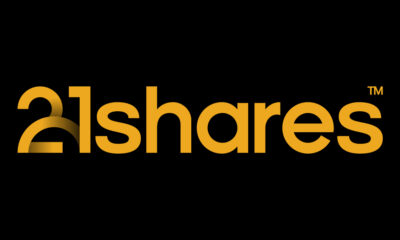
 Nyheter4 veckor sedan
Nyheter4 veckor sedanCrypto Market Risks & Opportunities: Insights on Bybit Hack, Bitcoin, and Institutional Adoption
-
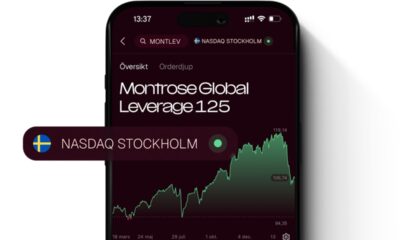
 Nyheter4 veckor sedan
Nyheter4 veckor sedanMontrose storsatsning på ETFer fortsätter – lanserar Sveriges första globala ETF med hävstång
-

 Nyheter4 veckor sedan
Nyheter4 veckor sedanSvenskarna har en ny favorit-ETF
-
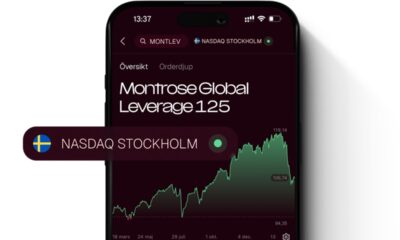
 Nyheter4 veckor sedan
Nyheter4 veckor sedanMONTLEV, Sveriges första globala ETF med hävstång
-

 Nyheter3 veckor sedan
Nyheter3 veckor sedanSju börshandlade fonder som investerar i försvarssektorn
-

 Nyheter3 veckor sedan
Nyheter3 veckor sedanVärldens första europeiska försvars-ETF från ett europeiskt ETF-företag lanseras på Xetra och Euronext Paris
-

 Nyheter4 veckor sedan
Nyheter4 veckor sedanEuropeisk försvarsutgiftsboom: Viktiga investeringsmöjligheter mitt i globala förändringar
-

 Nyheter3 veckor sedan
Nyheter3 veckor sedan21Shares bildar exklusivt partnerskap med House of Doge för att lansera Dogecoin ETP i Europa


